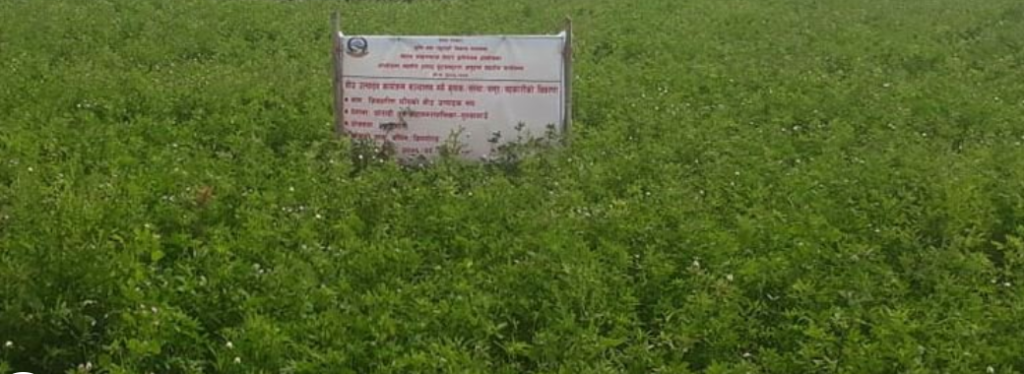Farmers in Dang reap lucrative income in Green Gold, Berseem Grass Farming

Deukhuri / Jan. 26: Farmers in Dang district have started earning a handsome income from commercial production of Berseem, known as the king of grass.
Many villages in Ghorahi Sub-Metropolitan City look lush green with the grass planted in the field as farmers have been attracted to commercial Berseem production lately.
Also called as ‘Green gold’, Berseem farming is considered to be highly beneficial for milk production of animals in winter season.
Shridhar Adhikari from Gorahi Sub-Metropolitan City-6 has started to plant Berseem grass in his two bighas of land currently instead of mustard, lentils and wheat which he used to cultivate in the past.
It has been four years since Adhikari started Berseem farming. “When it is green, it can be cut and fed to cows and it can be fed to domestic animals even if it gets dried up. Also, fruits sprouting out of Berseem grass can be sold as well so it is regarded as useful grass and is named as the king of grass,”.
I am raising four cows commercially. I do not have to wander around to find grass as I can easily get it from my own field. This saves my time as well, he said.
Meanwhile, he makes around a hundred thousand rupees per season from Berseem grass grown on a bigha of land. He sold Berseem grass seed worth Rs. 1.5 lakhs from his farm last year.
Sita Ram Chaudhary, from Gorahi-6, has planted Berseem on his 18 kattha of land. He said that there was compulsion to go to faraway forests to fetch grass but it has become easy now as he gets grass to feed his domestic animals from his own farm.
One can cut grass up to 4 to 6 times in a single season after planting it.
He shared that Berseem plantation does well to rice plantation as well.
After sowing the seeds, it is not difficult to cultivate and take care of Berseem grass. So farmers are attracted towards the grass plantation lately, he said.
Seeds of Berseem grass are sown the way the seeds of mustard and lentils are sown just before cutting the paddies and when the winter is yet to set on.
Paddies should be cut off at the time when Berseem starts to grow. Some people plant it by ploughing their fields. However, in Ghorahi, everyone plants it without ploughing. Both green and dried up grass is beneficial for animals.
Famers from Ghorahi-6 have been planting Berseem in 8 kattha to two and half bighas of land.
Farmers say that there is better earning from Berseem plantation than other plantation so many farmers are fascinated to Berseem plantation.
Farmers of Guruwa Gaun, Gurgai, Beruwagaun, Jajaragaun, Beragai, Fachakpur and Aghara villages of Ghorahi-6 have been cultivating grass.
At present, 150 households in the area are cultivating grass, said Bimal Adhikari, secretary of the Shiv Shakti Grass Seed Producers Association.
Adhikari said that farmers are attracted towards this as the investment is less and the income is lucrative.
The Shiv Shakti Grass Seed Producers Association has stated that the number of farmers planting Berseem grass is increasing every year as it saves farmers from going around in search of grass for the cattle they have.
According to the association, Berseem grass has been cultivated in 125 hectares of land so far.
Dang is the first district to cultivate Berseem grass commercially. Farmers sell a kg of grass seeds at Rs 200.
The association has been selling Berseem at the price fixed by the government. By grading, it is sold at Rs. 200 to 250 per kg. About 35 kg of the grass seeds is produced on a kattha of land.
Income from Berseem grass production is five to ten times more than from the production of paddy, so the attraction of farmers towards it has increased.
Secretary Adhikari said that Rs. 5 million worth of seeds were sold by the association from grass farming last year.
Some farmers have been selling Berseem to other places by themselves. He said that there will be more earning when the amount sold by farmers themselves is added as well. He estimated that the seeds of Berseem grass worth Rs. 8 million will be sold this year.
Commercially produced Berseem seeds in Dang have been sold to districts such as Morang, Sarlahi, Chitwan, Nawalparasi, Rupandehi, Kaski, Palpa, Banke, Bardiya, Kanchanpur, Surkhet, Pyuthan, Kathmandu, Lalitpur and Bhaktapur.
Commercial grass cultivation was started in Ghorahi-6 of the then Saudiyar VDC in 2000.
Berseem needs to be planted between months of Ashoj and Manshir (October to first half of December).
It provides good nutrients while feeding animals in the winter months (January to March). Even animals are found fond of this grass.
As the commercial rearing of cows, buffaloes and goats is increasing in the district, some farmers are cultivating only grass for their livelihood.
According to Dr. Bedh Bahadur KC, head of the Veterinary Hospital and Veterinary Services Center, Dang, this grass is nutritious for animals.
Dang is being developed as pocket area of Berseem plantation lately.
Dr. KC, said that the seeds could not be produced in other districts due to bad weather. He also said that Dang has a suitable environment for Berseem plantation.
